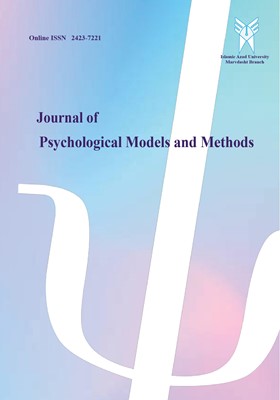بررسی اثربخشی آموزش تنظیم شناختی هیجان در بهبود عملکردهای روانی- اجتماعی در بین دانش آموزان مقطع متوسطه
الموضوعات :مرضیه جوادپور 1 , محمد خیر 2 , حجت اله جاویدی 3 , امیر هوشنگ مهریار 4
1 - گروه روانشناسی، واحد مرودشت، دانشگاه آزاد اسلامی، مرودشت، ایران
2 - گروه روانشناسی، واحد مرودشت، دانشگاه آزاد اسلامی، مرودشت، ایران
3 - گروه روانشناسی، دانشگاه آزاد اسلامی، مرودشت، ایران
4 - گروه روانشناسی، دانشگاه آزاد اسلامی، مرودشت، ایران
الکلمات المفتاحية: هوش, مهارت های اجتماعی, آموزش تنظیم شناختی هیجان,
ملخص المقالة :
مقدمه: هدف پژوهش حاضر بررسی اثربخشی آموزش تنظیم شناختی هیجان بر کارکردهای روانی- اجتماعی در دانش آموزان مقطع متوسطه شهر شیراز بود.
روش: روش پژوهش از نوع نیمه تجربی بود که از طرح دوگروهی پیشآزمون- پسآزمون با گروه شاهد و تخصیص تصادفی در گروههای مداخله و شاهد و پیگیری استفاده شد. نمونه پژوهش شامل 40 دانش آموز مقطع متوسطه بود که به شیوه خوشهای چندمرحلهای انتخاب و پس از غربالگری به طور تصادفی در دو گروه آزمایش و کنترل جایگزین شدند. برای اندازه گیری کارکردهای روانی- اجتماعی، شرکت کنندگان با پرسشنامه مهارت های اجتماعی ماتسون (1983) آزمون شدند. متغیر هوش نیز به عنوان متغیر کنترل درنظر گرفته شد. مداخله آزمایشی شامل آموزش تنظیم شناختی هیجان براساس مدل گراس به مدت 8 جلسه گروهی 2 ساعته بود. پس از اتمام برنامه آموزشی از هر دو گروه پس آزمون و آزمون پیگیری (دو ماه پس ازاجرای پس آزمون) به عمل آمد. به منظور تجزیه و تحلیل داده ها از روش تحلیل کوواریانس چندراهه استفاده گردید.
یافتهها: تحلیل نتایج نشان داد که آموزش تنظیم شناختی هیجان، تأثیر مثبت و معنی داری بر مؤلفه های کارکردهای روانی- اجتماعی دانش آموزان به جز بعد اطمینان بیش از حد به خود دارد(05/0 P<).
نتیجهگیری: با توجه به یافته های پژوهش حاضر می توان نتیجه گرفت که از آموزش تنظیم شناختی هیجان به منظور بهبود و ارتقای کارکردهای روانی- اجتماعی نوجوانان استفاده نمود.
1. Jokar, B. (1999). Normalization of the scale of two culture-independent intelligence tests of Katl for primary and secondary school children in Shiraz. Journal of Social Sciences and Humanities, 28, 21-40.
2. Yousefi, F., & Khayyer, M. (2002). Assessing the reliability and validity of the Matson Social Skills Scale and comparing the performance of high school girls and boys in this scale. Social Sciences and Humanities, Shiraz University. 18(2), 147- 158.
3. Alijanzadeh M, Makvand-Hosseini Sh, Kianersi F. (2014). The Effectiveness of Group Dialectical Behavior Therapy (Based on Skills Training) on Aggression in Adolescents. Journal of Clinical Psychology (JCP), 6 (23), 23-33.
24. Sadri Damirchi, A. & Esmaili Ghazivaloii, F. (2016). Effectiveness of social- emotional skills training on cognitive emotion regulation and social skills in children with learning disabilities. Journal of Learning Disabilities, 5(4), 59- 86.
_||_


